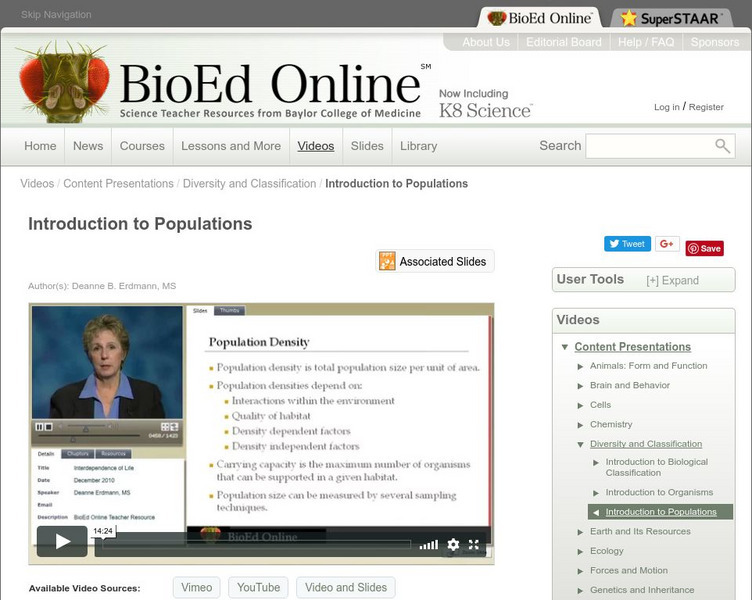Bozeman Science
Communities
What do you get if you cross ants with ticks? All kinds of antics! Video discusses the structure of the classifications in ecology. Then it covers the ways communities can be measured before discussing an example of leaf cutter ants...
Bozeman Science
Logistic Growth
A video on logistic growth begins with a review of exponential growth before moving on to limiting factors. This naturally leads to a decrease in the growth rate and a discovery of carrying capacity.
Crash Course
Population Ecology: The Texas Mosquito Mystery
While 80 percent of people with West Nile Virus show no symptoms, in severe cases, it causes death by infecting the membranes around the spinal cord and brain. The video starts by making population ecology relevant. It includes density...
PBS
Pbs Learning Media: Studying Antarctic Seals
Learn firsthand from a young Antarctic researcher about a long-term study on the reproductive history of Weddell seals in this video segment adapted from WomenInAntarctica.com. [3:33]
BioEd Online
Bio Ed Online: Introduction to Populations
What are the characteristics that define populations? What causes populations to grow or decline? In the following video you will learn how a population is a group of individuals of the same species living within a designated area at one...
BioEd Online
Bio Ed Online: Population Ecology
In the following video, Evan Seimann, PhD, defines key terms and concepts of ecology, basic characteristics of populations, population age structures and densities, and explains the dynamics of growth models within a population. [22:59]
Gilder Lehrman Institute of American History
Gilder Lehrman Institute: The American West: Urban v. Rural
Richard White, of Stanford University, discusses urbanization of the American West. [2:12]
PBS
Pbs: Human Numbers Through Time
In the following interactive you will examine global population growth over the past two millennia, and see what's coming in the next 50 years.
Khan Academy
Khan Academy: How Did Change Accelerate?
This video describes three factors for the acceleration of change: interconnected world zones, increasing commerce and markets, and new sources of fossil fuel energy. These factors led to the modernization of society in some parts of the...
University of California
University of California Television: Economics for a Crowded Planet
A televised overview of how we can reach sustainable development considering the continuing increase of population. Presented by the director of the Earth Institute at Columbia University, Jeffrey Sachs. [59:59] May 13, 2008
Khan Academy
Khan Academy:thomas Malthus and Population Growth
Thomas Malthus's views on population. Malthusian limits
Khan Academy
Khan Academy: Humanity on Earth: Thomas Malthus and Population Growth
Thomas Malthus's views on population. Malthusian limits. [8:13]
Khan Academy
Khan Academy: Humanity on Earth: Land Productivity Limiting Human Population
A video lecture exploring how land productivity limits the growth of a population. Video addresses how human population densities are limited by the calories that can be produced from the land. [12:59]
Khan Academy
Khan Academy: Bill Gates: Visions of the Future
Businessman and philanthropist Bill Gates looks towards a future of sustainable energy and worldwide education. [3:33]
Khan Academy
Khan Academy: Where and Why Did the First Cities and States Appear?
Fueled by surplus crops, agriculture led to the formation of the world's first large-scale civilizations. [10:45]
Khan Academy
Khan Academy: Human Prehistory 101 Part 3: Agriculture Rocks Our World
Fourth in a series of videos that introduces human prehistory, this video describes the origins of agriculture and its far-reaching effects on human history. [7:00]
NPR: National Public Radio
Npr Videos: Skunk Bear: 7 Billion: How Did We Get So Big So Fast?
Just over two centuries ago in 1804, the global population was 1 billion. But better medicine and improved agriculture resulted in higher life expectancy for children, dramatically increasing the world population, especially in the West....
















